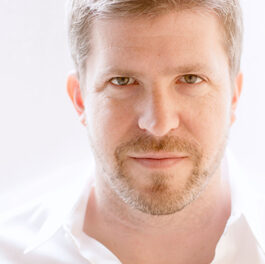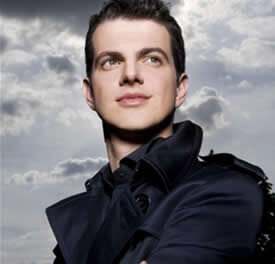This concert ranks high in my list of best ever performances: rock-solid rhythm, consummate virtuosity and variety of program left me hang-jawed and sockless, on a musical high perhaps best described by Aldous Huxley in Gates of Perception as “gratuitous grace.”
“Gratuitous” for the listener, perhaps, but there was lots of hard work for the musicians who played on the stage packed with instruments and music stands – xylophones, vibraphones, marimbas, cymbals, gongs, crotales (tiny pitched antique cymbals), bass drums, bright red Korean drums (7 sizes), snare drums, bongos, cowbells, rain sticks, claves, guiros, an assortment of maracas and shakers, even four decks of cards – anything that can be beaten, stroked, shaken or bowed (suspended cymbal bowed with a double bass bow) was on the stage and played, however briefly. The sounds range from unpitched, like the gong, to indistinct pitches (smaller is higher, bigger is lower) like suspended cymbals, bass and tenor drums and triangles to, at the opposite extreme, pitched and even tuned sounds such as the tympani, mallet instruments and crotales, able to play a full range of chromatic notes.
A repeat performance of this program by the Philidor Percussion Group will take place in the Recital Hall of the School of Music on the campus of the University of North Carolina in Greensboro (NC) on Monday, February 2, and should not be missed!
Entitled “Old School, New School,” the program mixed works of various styles and epochs, from 1915 to two world premieres by student composers. John Beck, Artist-Instructor of percussion at the University of North Carolina School of the Arts, introduced the pieces. The concert opened with “Lift-Off” (1966) by Greensboro composer, Russell Peck, a well-shaped piece with a clear climax and appropriate concluding coda. It featured some of the softest clearest rolls I have ever heard – like a handful of super-fine sand, trickling into the wind. Eventually the rolls augmented and changed timbres as the musicians changed beaters (drum sticks) and increased accents to the threshold of intolerance. The entire work was played by three musicians on an assortment of snare, tenor and bass drums.
John Cage’s Dance Music: for Elfrid Ide, first movement (1940), for six players, is a fast rhythmic and regular-metered piece which adds hand claps to the plethora of other instruments. The regularity of the meter provides a framework for the composer to change colors from bright and brassy to dark and somber. Two UNCSA students, Alex Aucoin and Scott O’Toole and UNCG faculty member, Peter Zlotnick, joined Philidor’s Rob Falvo, Wiley Sykes and Beck.
Four suspended cymbals, all playing rolls, followed by swashing tympani started the premiere performance of Michael Ahrens’ (b. 1972) interesting and avant-garde “Atmosfouric,” an atmospheric piece for four players. The first section is definitely about colors and the associations and moods they create; succeeding sections became rhythm-based, and the whole piece came to a satisfying conclusion with 5 widely spaced antique cymbal strokes, reminiscent of the end of Stravinski’s Les Noces. The work was directed by fellow NCSA student, Jared Steward.
Like many of us, I discovered and learned to love the tabla, India’s “talking drums,” from the LPs of Ravi Shankar, sitar and Alla Rakha, tabla. Wiley Sykes has written “Chaismata” (1995), a charming work for tabla (plus left hand bass drum) accompanied by three mallet instruments (two marimbas and a xylophone) who play a modal-sounding melody with many variants, while Sykes improvises to an 8-beat pattern. This change of pace work was followed by another premiere performance by UNCG composition student, Jonathon Salter, entitled “Chaos Drumming,” played entirely on the heads and rims of four different sized Korean drums. The work is constructed as a rhythmic canon, in which the parts imitate each other at regular intervals, in this case, by two 4/4 measures. The whole piece is intended to be loud and rhythmic and incorporates a shout from one or the other player a half beat before the cycle restarts. Opposite in style to “Atmosfouric,” this piece effectively uses the hypnotic effect of the rhythmic ostinato.
“Hit the Deck,” by David Noon (b. 1946) is a well-known novelty number which seats the four players at a square table and, in the middle, the score, printed in such a fashion that each player’s part is face-up for him. Each player has a deck of cards and uses it as a percussion instrument, hitting the table or a hand, shuffling the deck, cutting, dealing, discarding and ending (inevitably) with “52 card pick-up” – times four! This was hilarious and ingenious, a reminder that there is rhythm in potentially any everyday event. Noon, who teaches composition at the Manhattan School of Music, is an avid bridge-player!
The two last pieces in the concert were a couple of ragtime pieces written or arranged by George Hamilton Green for marimba solo and mallet accompaniment. The first, by short-lived composer Felix Arndt (1889-1918) bearing the title of his fiancée, “Nola,” (1915) was made famous in the 1950s by Les Paul. The soloist was John Beck who played with incredible skill and wit. The occasional cadenzas were positively dazzling and ended with the most subtle hints of rubato. Less familiar, but equally brilliant, was the last work on this hour-long program, G. H. Green’s “Rainbow Ripples” (1936), played no less brilliantly by Rob Falvo, a faculty member at the School of Music at Appalachian State University in Boone, NC.
A word is in order about the setting for this gem of a concert, Watson Chamber Music Hall, named for a couple of Winston-Salem music-lovers and philanthropists, Judy and Bill Watson. This is, in my experience, one of the most beautiful and acoustically exquisite halls in the Carolinas. Small (300 seats) and intimate, the hall was designed with the help of acoustician Rein Pirn, (Spivey Hall, Atlanta). Located on the beautiful campus of the University of North Carolina School of the Arts, it is the home of the aptly titled series “music@watson.”












